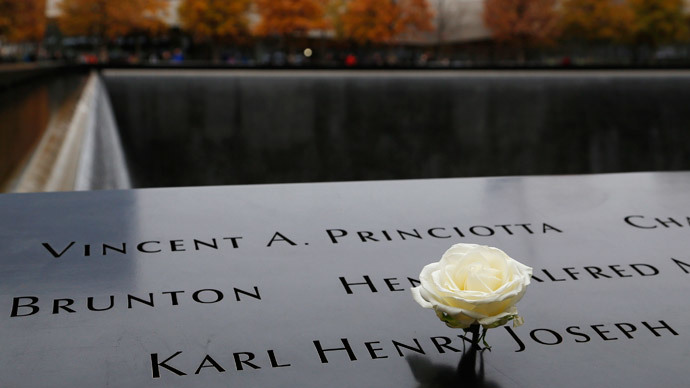CIA releases 9/11-related internal documents

Five documents assessing CIA conduct before and immediately after the 9/11 terror attacks were released Friday. The redacted files include the previously unavailable 2005 assessment of the CIA, as well as reactions by relevant officials.
“In response to FOIA requests for the full 2005 OIG report, CIA and other agencies conducted an extensive review of the nearly 500-page document in order to release information that no longer needed to be protected in the interests of national security,” the agency said in a statement.
One of the documents released on Friday is the redacted version of the 2005 report by the CIA Office of Inspector General (OIG), examining the agency’s accountability and intelligence community activities before and after the September 2001 terrorist attacks. The CIA had previously released only a heavily redacted executive summary of that report.
Among the new documents are two internal memos by CIA Director at the time, George Tenet, responding to drafts of the OIG report in February and June 2005. Versions of the August 2001 OIG report about the DCI Counterterrorism Center (CTC), and a July 2005 memo from 17 CTC officers responding to the 2005 OIG report, have been made public previously. Friday’s release, however, has disclosed some of the information previously redacted, “in light of the recent declassification of information on CIA’s counterterrorism operations,” the CIA said.
The five documents can be read at the agency’s FOIA page.
Fears the CTC may miss something
The August 2001 report on the CTC calls it a “well-managed component that successfully carries out the agency’s counterterrorist responsibilities to collect and analyze intelligence on international terrorism and to undermine the capabilities of terrorist groups.”
However, the report heard from some officers that the “demands placed on the CTC do not allow it to exploit all the information it receives. As a consequence, the risk exists that a potential warning will go unidentified.”
Pushback from Director Tenet, CTC
“Covert action is not successful in the absence of hard foreign intelligence,” George Tenet wrote in the first response to the OIG report, in February 2005. “It was clear to me at the time that while we had been somewhat successful in pursuing a law enforcement approach in battling Al-Qaeda, we did not have adequate SIGINT coverage and did not have enough human penetrations of Al-Qaeda.”
“We needed more and better basic intelligence,” the former CIA director wrote. “Covert action against Bin Laden and his key operatives was not possible without it.”
By June 2005, Tenet was still displeased the OIG was accusing him of “not devoting professionalism, skill and diligence in countering terrorism.”
“I object to and reject these accusations,” he wrote.
Tenet wrote that the National Security Council and the Attorney General of the US, rather than himself, had written the instructions sent to agents in the field that “made clear the Government’s policy preference was to capture Bin Laden and his principal lieutenants and render them to the United States.”
A July 4 memo, signed by 17 CTC officers, complains that the OIG was “concentrating its efforts on attempting to find individuals to blame.”
OIG report from June 2005
“Concerning certain issues,” the Inspector General Team “concluded that the agency and its officers did not discharge their responsibility in a satisfactory manner.”
“The team found no instance in which an employee violated the law, and none of the errors discussed herein involve misconduct.” The investigators found that the CIA “worked hard” against Al-Qaeda and Osama Bin Laden, but “did not always work effectively and cooperatively.”
“Basically, there was no coherent, functioning watchlisting program,” the OIG report argues, citing the example of Nawaf al-Hazmi and Khalid al-Midhar. The two were suspected Al-Qaeda terrorists whom the CIA tracked to Malaysia in January 2000.
However, none of the 50-60 CIA officers who had read the documents relating to the two men shared any information with other agencies. The CIA informed the State Department so late, the two men were only put on a terrorist watch list in August 2001. By that time, they were already inside the US, and would take part in the 9/11 hijackings.
The Saudi connection: Still redacted
READ MORE: Rand Paul seeks to tie Pentagon funding to release of classified 9/11 docs
As for the rumored “Saudi connection,” that section of the OIG report remains mostly redacted. The one part that was released amounts to the OIG admitting it “encountered no evidence that the Saudi Government knowingly and willingly supported Al-Qaeda terrorists.”
“Individuals in both the Near East Division (NE) and the Counterterrorist Center [REDACTED] told the Team they had not seen any reliable reporting confirming Saudi Government involvement with and financial support for terrorism prior to 9/11, although a few also speculated that dissident sympathizers within the government may have aided Al-Qaeda,” the report notes.
“A January 1999 Directorate of Intelligence (DI) Office of Transnational Issues Intelligence Report on Bin Laden’s finances indicated that ‘limited’ reporting suggested that ‘a few Saudi Government officials’ may support Osama Bin Laden but added that the reporting was ‘too sparse to determine with any accuracy’ such support,” the un-redacted portion of the document concludes.












